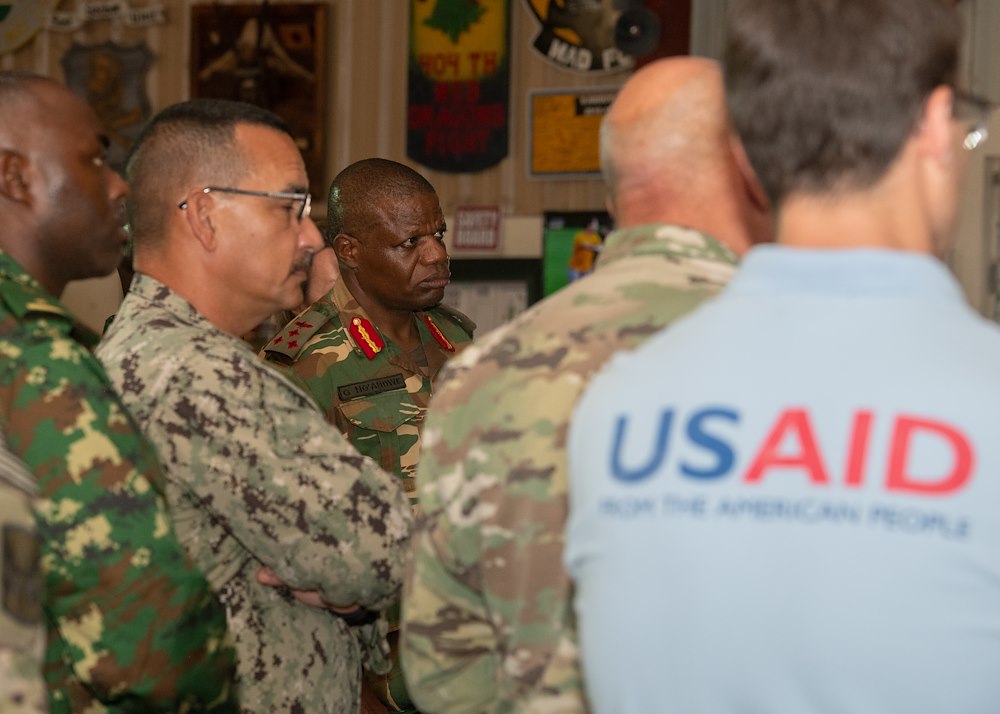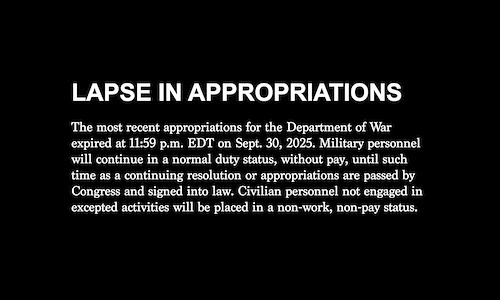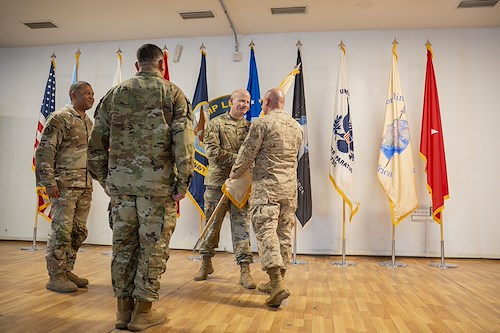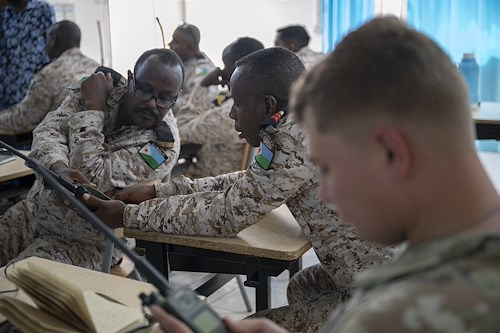Gallery contains 9 images
×
Photo 1 of 9
Combined Joint Task Force - Horn
Multinational service members and civil authorities work through a tabletop exercise involving simulated disaster scenarios throughout African countries during the Humanitarian Operations Workshop (HOW) on Camp Lemonnier, Djibouti, Nov. 30, 2022. The HOW, led by a team from the U.S. International Agency for International Development, provided an opportunity for U.S. service members, partner nation militaries, civil authorities, United Nation entities, and civilian response agencies to come together to enhance interoperability and improve coordination when responding to both natural and man-made disasters. (Department of Defense photo by U.S. Army Spc. Emily Held)
Photo by: Spc. Emily Held
Photo 2 of 9
Combined Joint Task Force - Horn
Elizabeth Blanchford, humanitarian assistance advisor to the Military with the U.S. Agency for International Development, speaks to participants during the Humanitarian Operations Workshop (HOW) on Camp Lemonnier, Djibouti, Nov. 30, 2022. The HOW, led by a team from the U.S. International Agency for International Development, provided an opportunity for U.S. service members, partner nation militaries, civil authorities, United Nation entities, and civilian response agencies to come together to enhance interoperability and improve coordination when responding to both natural and man-made disasters. (Department of Defense photo by U.S. Army Spc. Emily Held)
Photo by: Spc. Emily Held
Photo 3 of 9
Combined Joint Task Force - Horn
Multinational service members and civil authorities work through a tabletop exercise involving simulated disaster scenarios throughout African countries during the Humanitarian Operations Workshop (HOW) on Camp Lemonnier, Djibouti, Nov. 30, 2022. The HOW, led by a team from the U.S. International Agency for International Development, provided an opportunity for U.S. service members, partner nation militaries, civil authorities, United Nation entities, and civilian response agencies to come together to enhance interoperability and improve coordination when responding to both natural and man-made disasters. (Department of Defense photo by U.S. Army Spc. Emily Held)
Photo by: Spc. Emily Held
Photo 4 of 9
Combined Joint Task Force - Horn
Multinational service members and civil authorities pose for a photo at the Humanitarian Operations Workshop (HOW) on Camp Lemonnier, Djibouti, Nov. 30, 2022. The HOW, led by a team from the U.S. International Agency for International Development, provided an opportunity for U.S. service members, partner nation militaries, civil authorities, United Nation entities, and civilian response agencies to come together to enhance interoperability and improve coordination when responding to both natural and man-made disasters. (Department of Defense photo by U.S. Army Spc. Emily Held)
Photo by: Spc. Emily Held
Photo 5 of 9
Combined Joint Task Force - Horn
Multinational service members and civil authorities work through a tabletop exercise involving simulated disaster scenarios throughout African countries during the Humanitarian Operations Workshop (HOW) on Camp Lemonnier, Djibouti, Nov. 30, 2022. The HOW, led by a team from the U.S. International Agency for International Development, provided an opportunity for U.S. service members, partner nation militaries, civil authorities, United Nation entities, and civilian response agencies to come together to enhance interoperability and improve coordination when responding to both natural and man-made disasters. (Department of Defense photo by U.S. Army Spc. Emily Held)
Photo by: Spc. Emily Held
Photo 6 of 9
Combined Joint Task Force - Horn
Multinational service members and civil authorities work through a tabletop exercise involving simulated disaster scenarios throughout African countries during the Humanitarian Operations Workshop (HOW) on Camp Lemonnier, Djibouti, Nov. 30, 2022. The HOW, led by a team from the U.S. International Agency for International Development, provided an opportunity for U.S. service members, partner nation militaries, civil authorities, United Nation entities, and civilian response agencies to come together to enhance interoperability and improve coordination when responding to both natural and man-made disasters. (Department of Defense photo by U.S. Army Spc. Emily Held)
Photo by: Spc. Emily Held
Photo 7 of 9
Combined Joint Task Force - Horn
U.S. Army Maj. Gen. Jami Shawley, commanding general of Combined Joint Task Force - Horn of Africa (CJTF-HOA), welcomes participants to the Humanitarian Operations Workshop (HOW) on Camp Lemonnier, Djibouti, Nov. 29, 2022. The HOW, led by a team from the U.S. International Agency for International Development, provided an opportunity for U.S. service members, partner nation militaries, civil authorities, United Nation entities, and civilian response agencies to come together to enhance interoperability and improve coordination when responding to both natural and man-made disasters. (Department of Defense photo by U.S. Army Spc. Emily Held)
Photo by: Spc. Emily Held
Photo 8 of 9
Combined Joint Task Force - Horn
U.S. Army Maj. Gen. Jami Shawley, commanding general of Combined Joint Task Force - Horn of Africa (CJTF-HOA), gives opening remarks at a Humanitarian Operations Workshop (HOW) on Camp Lemonnier, Djibouti, Nov. 29, 2022. The HOW, led by a team from the U.S. International Agency for International Development, provided an opportunity for U.S. service members, partner nation militaries, civil authorities, United Nation entities, and civilian response agencies to come together to enhance interoperability and improve coordination when responding to both natural and man-made disasters. (Department of Defense photo by U.S. Army Spc. Emily Held)
Photo by: Spc. Emily Held
Photo 9 of 9
Combined Joint Task Force - Horn
Col. Padon Ninteretse, Burundi National Defense Force Headquarters in the department of Civil Military Coordination, gives a presentation on how Burundi facilitates humanitarian aid and disaster response during the Humanitarian Operations Workshop (HOW) on Camp Lemonnier, Djibouti, Nov. 29, 2022. The HOW, led by a team from the U.S. International Agency for International Development, provided an opportunity for U.S. service members, partner nation militaries, civil authorities, United Nation entities, and civilian response agencies to come together to enhance interoperability and improve coordination when responding to both natural and man-made disasters. (Department of Defense photo by U.S. Army Spc. Emily Held)
Photo by: Spc. Emily Held
The Combined Joint Task Force - Horn of Africa (CJTF-HOA), in coordination with the U.S. Agency for International Development (USAID) and their Bureau for Humanitarian Assistance (BHA), hosted multinational military partners and civil authorities for a Humanitarian Operations Workshop (HOW) at Camp Lemonnier, Djibouti, Nov. 29 - 30.
“This Humanitarian Operations Workshop might be the most singularly important workshop that we have hosted this year,” said U.S. Army Maj. Gen. Jami Shawley, commanding general of CJTF-HOA.
The HOW provided an opportunity for U.S., partner nation militaries, civil authorities, United Nations entities, and civilian response agencies to come together to enhance interoperability and improve coordination when responding to both natural and man-made disasters.
“This exercise is very good for us because we have all the foreign forces with us and we can simulate a real-life scenario,” said Fatoum Chirwa, Djibouti’s executive secretariat for risk and disaster management. “We gain a lot of experience so that when a situation happens we know what to do and know how to answer.”
During the first day of the workshop, each nation’s military participant provided a presentation on their country’s humanitarian aid and disaster response.
Col. Padon Ninteretse, Burundi National Defense Force Headquarters in the department of Civil Military Coordination, said he was able to share how Burundi was assisting neighboring countries with food and water security during his presentation.
“It’s nice to do a workshop like this because we get to meet with partners and other countries and share our experiences, and you can learn from each other,” said Ninteretse. “You see how others do things and you can replicate the best.
“When I go back to Burundi, I will share what I learned from this workshop,” Ninteretse added.
On the second day of the workshop, partners participated in three tabletop exercises to work through how they would apply aid and response efforts to humanitarian crises.
“There are countries that have more experience in natural disasters and they can share that,” said Maj. Alberto Lancioli, the foreign liaison officer for the Italian base in Djibouti, Africa.
Lancioli added that he has learned from many African countries here. One example he shared was that Djibouti had a red insect infestation which was similar to a problem experienced in Italy a few years ago. He said it would have been nice to learn how other countries responded sooner, which is why this workshop and collaboration are so important.
Having all the Eastern and Southern Africa key players for Humanitarian Assistance and Disaster Relief response efforts in one room provided a space for everyone to grow and share their experiences.
“We can compare notes, see our similar approaches, see what differences we have, and where we can complement each other,” said Regina Omlor, humanitarian affairs officer for the United Nations Office for the Coordination of Human Affairs Regional Office for Southern and Eastern Africa.
“It’s incredible, we are going to take back what we learned and disseminate that to our teams and hopefully strengthen our approaches as well,” Omlor added.
The workshop brought partners together to have face-to-face conversations and enhance relationships.
“CJTF-HOA's area of responsibility is Eastern and Southern Africa, so now we actually get to see and bring everyone together from the countries where we may actually conduct military-to-military engagements or may have to push out assistance to respond to humanitarian crises,” said U.S. Army Capt. Victoria Rossi, future operations officer for Civil Affairs East Africa.
The HOW included approximately 50 participants from more than 12 countries as well as other military and civil organizations working together to improve programs, operations and cooperation between them.
“Having all the partners here in the room helps make this workshop successful because it really depends upon the content they provide,” said Matt Lonnquest, a USAID humanitarian assistance advisor to the U.S. Africa Command. “The majority of the discussions yesterday and the content today is not U.S. centric. It is focused on the partners and how our foreign militaries connect, because the expectation is that we operate under the same set of guidelines and principles and so setting that standard can only happen with everyone here.”
The first Humanitarian Operations Workshop in Djibouti took place during COVID-19, with limited personnel from Spain, Djibouti, the World Food Program and the U.S. military. This year’s workshop provided more opportunities for discussion and facilitated maximum participation from multiple nations.
Lancioli said holding future workshops would be beneficial for new leaders taking on greater responsibilities.
Ninteretse agreed.
“You see everywhere there are disasters or other troubles occuring,” Ninteretse said. “That’s why there is a need to expand this knowledge to other countries.”































